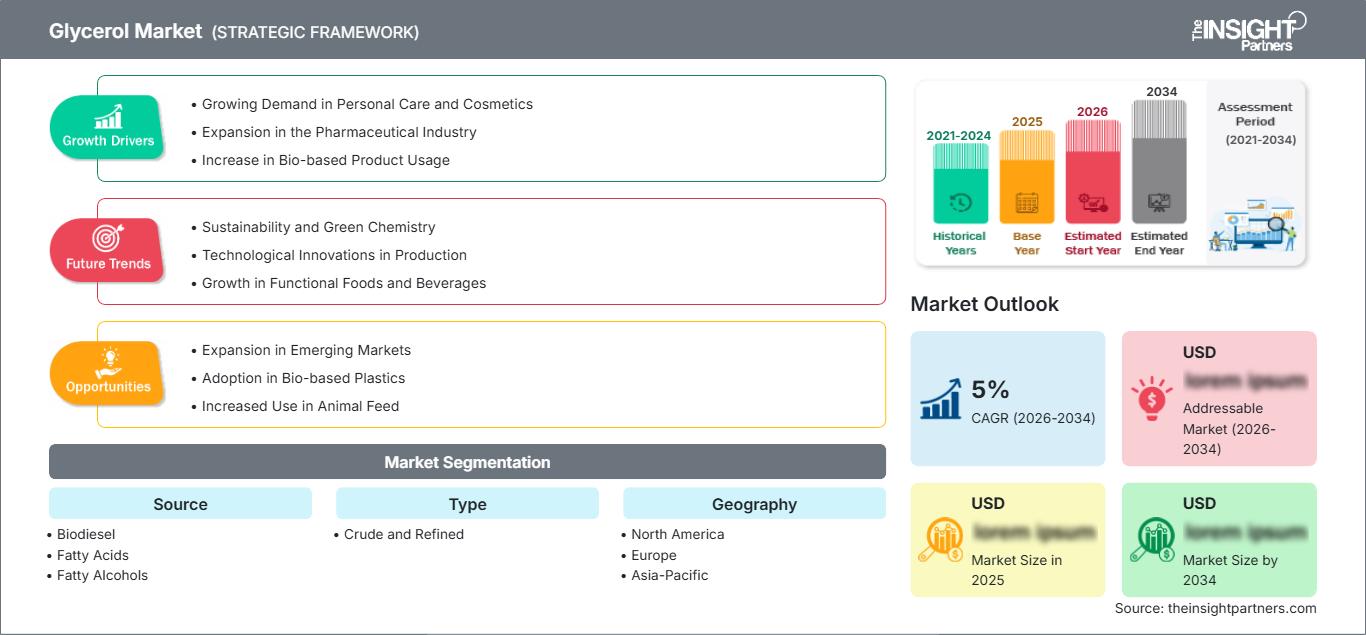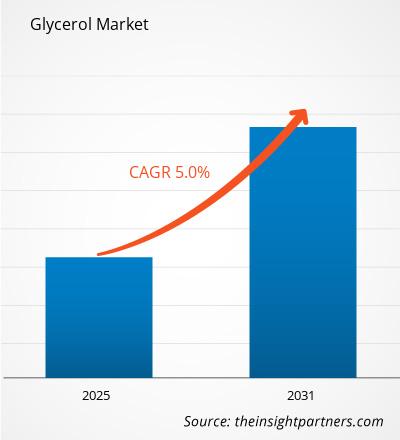Le marché du glycérol devrait croître à un TCAC de 5 % entre 2026 et 2034. L'évolution constante du marché offre de nouvelles opportunités aux acteurs concernés. Le contexte général témoigne d'une progression stable et d'un fort potentiel de croissance à long terme.
Le rapport est segmenté par source (biodiesel, acides gras, alcools gras et savon). Il présente également une analyse par type (brut et raffiné) et par utilisation finale (agroalimentaire, pharmaceutique, nutraceutique, cosmétique et soins personnels, industrie et autres). L'analyse globale est ensuite ventilée par région et par grands pays. Le rapport indique la valeur en dollars américains pour les analyses et segments mentionnés ci-dessus.
Objectif du rapport
Le rapport « Marché du glycérol » de The Insight Partners vise à décrire le contexte actuel et la croissance future, les principaux facteurs de croissance, les défis et les opportunités. Il fournira des informations précieuses à divers acteurs du secteur, tels que :
- Fournisseurs de technologies/Fabricants : Pour comprendre l’évolution de la dynamique du marché et connaître les opportunités de croissance potentielles, afin de prendre des décisions stratégiques éclairées.
- Investisseurs : Réaliser une analyse complète des tendances concernant le taux de croissance du marché, les projections financières du marché et les opportunités existantes tout au long de la chaîne de valeur.
- Organismes de réglementation : Réglementer les politiques et les activités de police sur le marché afin de minimiser les abus, de préserver la confiance des investisseurs et de maintenir l’intégrité et la stabilité du marché.
Source de segmentation du marché du glycérol
- Biodiesel
- Acides gras
- Alcools gras
- Savon
Taper
- Pétrole brut et raffiné
Vous bénéficierez d'une personnalisation gratuite de tous les rapports, y compris certaines parties de ce rapport, l'analyse par pays, le pack de données Excel, et vous profiterez également d'offres et de réductions exceptionnelles pour les start-ups et les universités.
Marché du glycérol : Perspectives stratégiques

-
Découvrez les principales tendances du marché présentées dans ce rapport.Cet échantillon GRATUIT comprendra une analyse de données, allant des tendances du marché aux estimations et prévisions.
Facteurs de croissance du marché du glycérol
-
Demande croissante en soins personnels et cosmétiques : La demande croissante des consommateurs pour des produits de soins personnels naturels et durables stimule le marché du glycérol. Portée du rapport sur le glycérol
Aperçu régional du marché du glycérol
Les tendances régionales et les facteurs influençant le marché du glycérol tout au long de la période prévisionnelle ont été analysés en détail par les analystes de The Insight Partners. Cette section aborde également les segments de marché et la répartition géographique du glycérol en Amérique du Nord, en Europe, en Asie-Pacifique, au Moyen-Orient et en Afrique, ainsi qu'en Amérique du Sud et centrale.
Portée du rapport sur le marché du glycérol
EuropePar type- Pétrole brut et raffiné
- ROYAUME-UNI
- Allemagne
- France
- Russie
- Italie
- Le reste de l'Europe
- Chine
- Inde
- Japon
- Australie
- Reste de l'Asie-Pacifique
- Brésil
- Argentine
- Le reste de l'Amérique du Sud et centrale
- Afrique du Sud
- Arabie Saoudite
- Émirats arabes unis
- Le reste du Moyen-Orient et de l'Afrique
Attribut du rapport Détails Taille du marché en 2025 XX millions de dollars américains Taille du marché d'ici 2034 XX millions de dollars américains TCAC mondial (2026 - 2034) 5% Données historiques 2021-2024 Période de prévision 2026-2034 Segments couverts Par source - Biodiesel
- Acides gras
- Alcools gras
- Savon
Régions et pays couverts Amérique du Nord - NOUS
- Canada
- Mexique
Leaders du marché et profils d'entreprises clés - BASF SE
- Cargill, Incorporated
- DOW Chemical
- Société Kao
- KLK Audio
- Oléon NV
- Pacific Oleochemicals Sdn Bhd
- Willmar International
Densité des acteurs du marché du glycérol : comprendre son impact sur la dynamique commerciale
Le marché du glycérol connaît une croissance rapide, portée par une demande croissante des utilisateurs finaux, elle-même alimentée par l'évolution des préférences des consommateurs, les progrès technologiques et une meilleure connaissance des avantages du produit. Face à cette demande grandissante, les entreprises diversifient leur offre, innovent pour répondre aux besoins des consommateurs et tirent parti des tendances émergentes, contribuant ainsi à la croissance du marché.

- Obtenez un aperçu des principaux acteurs du marché du glycérol
- Analyse historique (2 ans), année de base, prévision (7 ans) avec TCAC
- Analyse PEST et SWOT
- Taille du marché Valeur / Volume - Mondial, Régional, Pays
- Industrie et paysage concurrentiel
- Ensemble de données Excel
Rapports récents
Témoignages
Raison d'acheter
- Prise de décision éclairée
- Compréhension de la dynamique du marché
- Analyse concurrentielle
- Connaissances clients
- Prévisions de marché
- Atténuation des risques
- Planification stratégique
- Justification des investissements
- Identification des marchés émergents
- Amélioration des stratégies marketing
- Amélioration de l'efficacité opérationnelle
- Alignement sur les tendances réglementaires






















 Obtenez un échantillon gratuit pour - Marché du glycérol
Obtenez un échantillon gratuit pour - Marché du glycérol